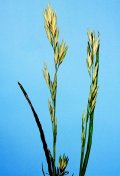
Prairie grass

Prairie grass
(High-resolution
image available)
| Pasture type and use | Annual to short-term perennial grass. Pasture life can be extended by good management. |
|---|---|
| Area of adaptation | Coast, Hunter, tablelands and irrigation areas. |
| Min. average annual rainfall | 850 mm |
| Advantages |
|
| Disadvantages |
|
| Soil requirements | Requires highly fertile well-drained soils, with best growth on soils with pH(Ca) 5.5 or above. Performs poorly on waterlogged soils. Responds well to nitrogen fertiliser for best yields. |
| Varieties | Grasslands Matua Atom Tango |
| Sowing rate - in mixtures | Up to 7 kg/ha in mixtures with other perennial grasses, but can be better managed as pure swards. 20–30 kg/ha in intensive swards with legumes. This should be increased to 40–60 kg/ha with white clover added for high rainfall or irrigated pastures, where financial returns are expected to be high. |
| Sowing time | Early autumn |
| Companion species | Can be included with most pasture grasses and legumes, but because of lax rotational grazing requirements, is best sown as the only grass in mix with legumes. |
| Inoculation | N/A |
| Major nutrient deficiencies | Nitrogen, phosphorus and sulfur; possibly potassium and other site-specific nutrients as required. |
| Main insect pests | Army worm |
| Main diseases | Head smut (Ustilago bullata) — for control, treat seed with a registered seed dressing prior to sowing. |
| Management | Where intensive grazing management is possible, follow these guidelines:
From sowing, graze at a time equivalent to reach 3–4 new leaves/tiller, which will be 30–35 days in mid-winter to 20–22 days in spring. However, this may be compromised by soil moisture, as it seems critical not to graze when the soil is waterlogged. There appears to be no advantage in deferring grazing in early autumn to allow the new prairie grass seedlings to establish. In fact, if there are weeds present, the effect of deferment from grazing is negative on prairie grass production. If invasion by summer grasses becomes significant, spray out whole pasture with herbicide (rate and herbicide type depends on weeds present) any time after mid-February and at the time the prairie grass seed begins to germinate. This practice may need to be repeated every 2 years but this depends on the weed seedbank. Such a practice has the potential to lead to a permanent temperate grass pasture. Grazing fairly lax from October onwards at 20-day to 22-day intervals should allow adequate seed-set to re-establish seedlings the following autumn. |
| Livestock disorders of particular note | Awns may penetrate skin of sheep; possible wool contaminant. |
| Additional tips | Can be established with conventional cultivation or direct drilling. |
Acknowledgment
Advice on livestock health was provided by Dr Chris Bourke, Principal Research Scientist, NSW Agriculture, Orange. His contribution is gratefully acknowledged.

